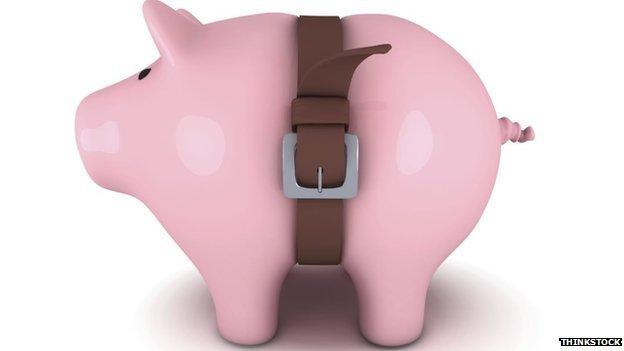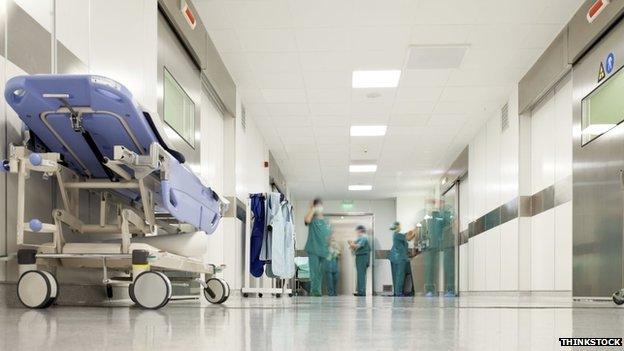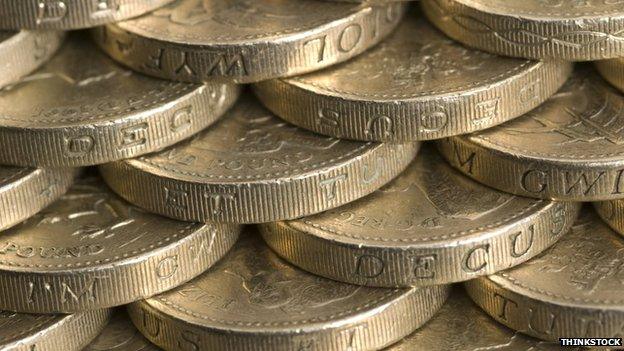Reality Check: Would the SNP end austerity, or stack up future debt?
- Published

The Scottish National Party wants to be seen as different. It wants to avoid the old Westminster ways. It offers voters "equality, fairness and an end to austerity".
Yet it wants also to emphasise how similar it is to Labour, using its manifesto both to woo Scottish voters and to woo Labour's future MPs in England and Wales.
This is designed to look like the manifesto that a lot of Labour activists would prefer to be selling on the doorstep. That includes opposition to nuclear deterrent renewal.
And the SNP has thrown in support for Labour policies - on a 50% top earner tax band, a mansion tax and a bank bonus tax (confident that very few in Scotland would be affected).
Where SNP and Labour diverge most clearly is where there's just enough red meat on bringing more powers to Holyrood to satisfy the vast cohorts of new SNP members.
That different-but-the-same approach is not the only paradox. The Scottish National Party attacks the coalition government for failing to get the deficit down, as planned, and then argues that it was wrong to try to do that anyway, and the policy should be thrown into reverse.
Also, the SNP spent the independence referendum campaign telling Scots that there was no point in Scots continuing to send MPs to Westminster because they always get out-voted. In the expectation of a hung parliament and a few dozen SNP MPs, that certainly isn't the message now.
Much of this is about politics. But how do the numbers stack up? What does it mean to 'end austerity'? How much of it is to benefit Scotland, and how much the rest of the UK? And is all this as different as the SNP tells us?

What would the SNP do with the public finances?

The party wants to increase departmental spending by 0.5% per year, in real terms, over the next parliament. When Nicola Sturgeon first said this, in February, it added up to another £180bn of spending. Her manifesto says £140bn.
The Resolution Foundation has looked at the figures, and says it looks like £180bn in 2019-20 figures, and £160bn at today's prices.
To give you a sense of proportion, this year's UK deficit looks like being £76bn, and the debt is heading north of £1,500bn.

Wouldn't that increase the UK debt?

Yes, in money terms. But if that money is spent on infrastructure and innovation - and perhaps even if it's not - it could help boost the economy's growth rate. So the SNP leader argues that, after five years, debt would be falling as a share of GDP.
In other words, if the pie gets bigger at a faster pace than the debt increases to help make it bigger, then the share of debt heads down towards 70% of Gross Domestic Product.
That's a big 'if'. SNP policy people like to be rosily optimistic. In setting out plans for fiscal autonomy in Scotland, they assume that control of the economic levers will lead to a sustained higher level of productivity growth, plus a 50% increase in exports, plus a rise in business investment to the levels of similar small countries. Their scenario planning rarely much effort into calculating downside risks.
This plan also requires that the UK continue to borrow on the bond markets at very low rates. That isn't guaranteed. George Osborne has been telling us that the rates are low because of his long term economic plan, whereas they have gone up where there's eurozone uncertainty about the commitment to getting deficits down.
So while the SNP wants growth by government stimulus, Conservatives want to stimulate growth by reducing the burden of debt as soon as possible. But the argument is that the Tory plans could stunt growth, and has done so in the past five years, which is why the books are a long way from being balanced and the debt keeps rising.
Ms Sturgeon goes on to argue that government spending doesn't just buy higher growth, but fairness and social cohesion.

Would that plan 'end austerity'?
That depends first on whether you think austerity has yet been tried. There has been a squeeze on some services, and cuts to welfare benefits, but you could argue that real austerity has barely started.
Then you have to assume that 0.5% real terms increase in departmental spending is sufficient to retain public services.
It could send a signal to public sector workers to push for some reimbursement for the austerity years. If they get their way, that 0.5% increase would disappear very fast.

And while the NHS has been ring-fenced from real terms cuts throughout Britain, most health economists reckon it faces roughly 4% annual inflationary costs, so the squeeze wouldn't end with the 0.5% stimulus.
It would be helped, however, with the £9.5bn additional stimulus in the SNP manifesto. That appears to respond to the £8bn the English NHS chief says is needed, with a large amount of headroom to ensure shares for Scotland, Wales and Northern Ireland.
Labour's calculation, by contrast, is to talk up its commitment to fiscal discipline, as it did in 1997. If the rhetoric continues to be about straitened times, it could make it easier to effect public sector reform, and easier to say 'no' to demands for more spending from ministers, backbenchers and outside lobbyists.

Isn't the SNP all about getting more for Scotland?
That's what David Cameron is saying - "these people don't care about your hospital or by-pass" in England - and some commentators have echoed that.
But in contrast with Leanne Wood of Plaid Cymru, that is what Nicola Sturgeon seems keen not to say. The manifesto seeks to send a message about setting priorities responsibly for the benefit of all parts of the UK.
The price may be, for instance, a higher Whitehall priority for high-speed rail through the north of England and linking with Edinburgh and Glasgow.
But the manifesto's uplift in public service spending is not aimed at skewing mainstream spending towards Scotland (any more than the Barnett Formula for distributing money to Scotland, Wales and Northern Ireland already does).
Indeed, the SNP is in a difficult position on the very much larger deficit that Scotland appears to be running, and would prefer to avoid discussion of the Barnett Formula and spending in Scotland.
That's because it wants to replace the Barnett Formula with the full range of tax powers at Holyrood, as a substitute for independence, or a staging post towards it. But it doesn't want that until it has figured out a way to make the transition without a very large and painful jolt, of about £7-8bn per year, to public service funding in Scotland.

How distinctive is the SNP approach?
It has, in common with the main Westminster parties, the aim of getting the debt down, eventually.
The difference with Labour is that Ed Balls has pledged to get the budget into surplus "as soon as possible" and before the end of the next parliament. The Institute of Fiscal Studies has said that Labour could follow the same profile as the SNP, if it were willing to delay a year or two more.

Scottish Labour leader Jim Murphy has emphasised as much, but was firmly and publicly told by the Westminster leadership that the squeeze will be implemented, and fiscal discipline will be applied to Scotland as well as the rest of the UK.
The Resolution Foundation has also concluded that the SNP plan is not that far removed from Labour's. One favours a 0.5% real terms per annum rise in departmental spending: the other plans to implement a 0.5% real terms cut.
The think tank translates that to the SNP ending the next parliament with £60bn per year more spending, and Labour on £48bn more.
These differences add up to tens of billions of pounds of debt. But given the other variables in any forecasting model, the percentages are quite small and the differences easily lost amid other factors - whether a different tax take than forecast, or an unexpected spending pressure, such as extreme weather, pandemic or war.
Of course, while the debt keeps rising, and the longer it isn't reduced, that will be money spent on servicing debt, which could otherwise by spent on public services.
In other words, the plan may involve roughly the same amount of pressure on public service funding, but some of it would be postponed, instead affecting taxpayers and service users far into the future.

Election 2015 - Reality Check

What's the truth behind the politicians' claims on the campaign trail? Our experts investigate the facts, and wider stories, behind the soundbites.
Read latest updates or follow us on Twitter @BBCRealityCheck, external
